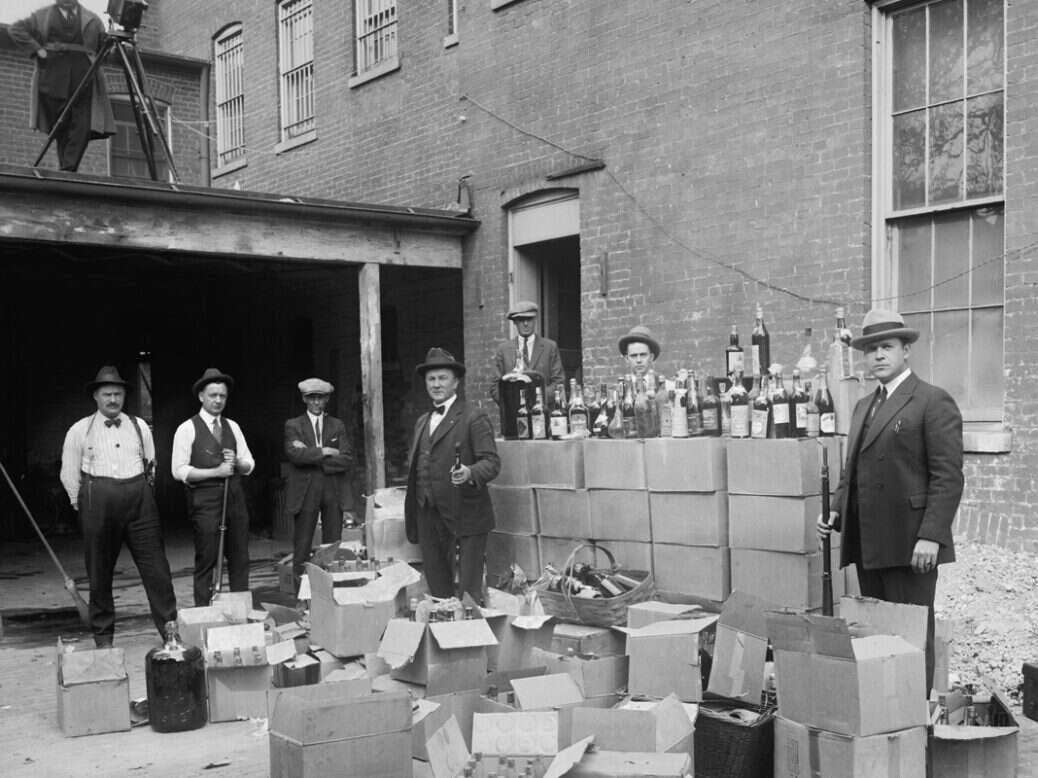
As the United States marks a century since the beginning of Prohibition, could the surge in online sales prompted by the Covid-19 crisis spell the beginning of the end for the strictly enforced three-tier system that has been in place since Repeal?
This January saw a US centenary little observed, and even less celebrated. On January 17, 1920, the Great Experiment, Prohibition, went into effect. For the next 13 years, alcohol was banned throughout the nation. In popular culture, it gave us NASCAR and an entire genre of film dedicated to organized crime. The legal ramifications of Prohibition and the manner of its repeal have also lingered, establishing the structure of today’s US alcohol market. But 100 years since Prohibition began, several developments are prompting changes that may substantially revise that structure: online sales, market diversity, and most recently, Covid-19.
One could argue, of course, that the centenary of “modern” alcohol distribution remains 13 years away, that it’s the legacy of laws enacted upon Prohibition’s repeal, not the legacy of Prohibition’s enactment, with the alcohol industry is struggling. But the leading forces behind the post-Prohibition framework were very much concerned to control and limit alcohol consumption, and many were the very same people who had advocated for Prohibition years earlier. They had simply changed their goals; the side effects of abolishing alcohol had proved too costly, so they developed a containment strategy. At the core of this new strategy was the question: “When it comes to buying alcohol, how much difficulty are Americans willing to tolerate?”
Among the high-profile temperance advocates, going back several decades, was the Rockefeller family. John D Rockefeller, a lifelong teetotaler, supported the two major temperance advocacy organizations, the Anti-Saloon League and the Women’s Christian Temperance Union; his wife was a charter member of the latter. By 1932, however, Rockefeller became convinced that Prohibition had not only failed to alleviate the social ills temperance supporters attributed to alcohol, but had created a lawless society. That year he declared, “…that drinking generally has increased; that the speakeasy has replaced the saloon, not only unit for unit, but probably two-fold if not three-fold; that a vast army of lawbreakers has been recruited and financed on a colossal scale… I have slowly and reluctantly come to believe.”
When repeal came in 1933, the idea that state or local authorities would be responsible for setting alcohol policy was already in keeping with the approach of temperance advocates. While national Prohibition may once have been the crowning achievement of the movement, it was their grassroots strategy, embraced as early as the mid-19th century, that got them there. Efforts had focused on enacting local anti-alcohol ordinances for decades. Momentum grew, and local ordinances blossomed into state laws. Maine passed its prohibition law all the way back in 1846, and 17 states had such laws on the books by 1917. The movement accelerated, and by the time the national Volstead Act passed two years later, 33 states already had their own laws on the books. So, when federal laws were repealed, it was quite natural for temperance advocates to revert to the local and state approach that had worked so well for them previously.
Enforcement at the state level was much more practical. There had been a federal force during the Prohibition eras, but despite the high profile of people like Eliot Ness and his Untouchables, the number of officers was entirely inadequate to the task, so the federal law relied on state and local law enforcement agencies for implementation. Many of these agencies were not terribly interested. Some simply refused to cooperate with federal authorities, in a manner reminiscent to the more recent tensions between Immigration and Customs Enforcement and the governments of so-called sanctuary cities today. New Jersey, for one, chose not to bother enforcing Prohibition, leaving the job to a small, overworked force of federal agents. States did not turn their back on the need for enforcement or the opportunity to collect tax revenue once the 21st Amendment put alcohol regulations into their own hands, even if the federal government did retain the right to collect its own excise taxes.
When individual states looked for a model on how to structure their regulatory systems, they turned once more to John D Rockefeller. With repeal approaching, in early 1933 New York governor Herbert Lehman asked Rockefeller to chair a committee on the subject. He declined, but commissioned a study on the issue. Raymond Fosdick and Albert Scott authored the resulting report, “Toward Liquor Control,” but Rockefeller provided the introduction and it is often referred to as the Rockefeller Report. In his introduction Rockefeller called for regulatory structures that encouraged temperance, with the understanding that structures designed to enforce abstinence had failed. “Toward Liquor Control” provided the core principles under which most states created their own statutory systems for alcohol distribution, taxation, and sales.
As the Center of Alcohol Policy outlines in its own introduction to a 2011 reissue of the report, four major themes emerge, all of which have had an impact on individual state regulations. Fosdick and Scott looked to European models of regulation for inspiration, and the report comes down strongly in favor of state-managed, state-monopolized distribution and sales of alcohol, in the manner of Sweden’s Systembolaget. It does caution that such an approach may not be in keeping with American concepts of free enterprise. Should a state choose to keep alcohol sales in private hands, it advocates against vertical integration within the alcohol market. The statutory models that emerged tend to be based primarily on these two principles. On one hand you have the state-run stores found in Pennsylvania and New Hampshire, where all alcohol aside from beer passes through the hands of the government; on the other, the three-tier system, wherein vertical integration is prevented via a separation of producer, wholesaler, and retailer. A third theme is that lower alcohol products, wine and beer, specifically, should be treated differently than spirits. The intention is that those who do drink should be encouraged to indulge in these lighter alcohol beverages in favor of more deleterious strong drink. “States must use their control systems to steer society to lower alcohol forms of products.”
The final theme, and probably the one most relevant to looking at what’s happening today, is that the laws must be acceptable to the people. In other words, don’t make laws so onerous that drinkers turn to the black market. As the report itself concludes: “If the new system is not rooted in what the people of each state sincerely desire at this moment…it cannot succeed.” The structures existing may indeed have been acceptable and “sincerely desired” at the time of enactment, when drinkers were by-and-large mostly relieved to be able to drink legally at all, but today’s drinkers would like to go a bit further than that.
Consumers the awaking giant
Each state’s regulatory system has evolved to some degree or another. The direction of their evolution has largely depended on the tension between two forces. One is, indeed, what limitations contemporary drinkers are willing to tolerate. The other is a force that the report, in its strong advocacy of the state as the seller of alcohol, hoped to suppress. As the Center of Alcohol Policy puts it, “a state-run system would prevent the gradual erosion of alcohol controls by those with economic interest in the alcohol business.” Those with an economic interest have indeed eroded, manipulated, and exploited those controls. Most of the resulting legislative efforts and lawsuits and legislative efforts pitch consumers, often in consort with the public-facing parts of the industry—producers or retailers—against the “invisible” middle tier of wholesalers.
The power and influence of the wholesale tier has increased dramatically in recent years, and the numerical relationship between suppliers and wholesalers has become almost entirely inverted from what it was when Prohibition was ending and the three-tier structure was coming into being. At that time there were fewer than 400 wineries in the US; by 1995, there were 1,800, and that number then ballooned to 9,200 in just 25 years. That’s just domestic production; imports make up almost one third of wines sold in the US, coming from well-known, classic regions, all the way to the most obscure. As brands have multiplied, the number of distributors, conversely, has shrunk to almost one third their number in that same quarter-century. Distributors have not been shy about supporting politicians who help them maintain their primacy in alcohol’s supply chain, and with that concentration of power have become major political donors. Southern Wine & Spirits and Glazier’s merged in 2016, and is now the country’s largest distributor, operating in 44 states. According to Follow The Money, which tracks political donations, the company has donated almost $4 million to political campaigns in the short time since the merger.
The power of the consumer may not have grown as significantly; rather, it is a sleeping giant that has begun to awaken. For quite a while, many of their victories were small. Since the millennium, for example, many so-called blue laws which forbid the sale of alcohol on Sundays have been struck from the books. Reasonable enough, but hardly a cause for great celebration. For a long time, drinkers’ awareness of the barriers facing alcohol sales in America were confined to Buzzfeedesque lists of particularly nonsensical statues: In Alabama, beer is required to be sold at room temperature. In Utah, restaurant bartenders must prepare mixed drinks behind a curtain. And so forth. Aside from that, it was mostly a matter of knowing where and when to shop. A Californian visiting New York might be surprised to find they can’t buy wine in a grocery store; the New Yorker, in turn, is startled to see people buying beer “to go” from bars in Pennsylvania.
Internet transparency
If the grass is always greener on the other side, nothing has given American wine drinkers a glimpse of that side like the Internet. This is particularly true when it comes to wine selection. The availability of many, many wines can seem hugely arbitrary, owing to the patchwork nature of wine distribution. Today’s consumer is much more aware of these restrictions than they would have been in the past. Online sales have been growing steadily. When one logs on to wine.com, before you can order you must first tell the website what state the wines will be shipped to. Similarly, wine-searcher.com reveals both availability issues and state-by-state price discrepancies. The frustrating “Available in other states” search response alerts wine drinkers that not every American has access to the same, national cellar. The Internet has brought much greater transparency to these restrictions, and wine drinkers have noticed.
The Internet has created new market expectations that retail alcohol sales have not been empowered to keep up with. Tom Wark, a wine marketing and PR consultant and a strong proponent of the rights of wine drinkers, outlines the problem well in an Op-Ed he wrote for the Columbus Dispatch. In just May, June, and July of this year, the federal government approved 350,000 wine labels. Less than one fifth of that number of wines are actually available to Ohio wine drinkers. Wine fans in other states face similar issues. And in many states, wines cannot be shipped in from outside the state. Wark’s Op-Ed was actually inspired by lawsuits filed by wine-collecting Ohioans who wished to have wines shipped to them from out-of-state retailers.
The first major crack in laws that prevented shipping wine across state lines came in 2005 when the Supreme Court heard the Granholm vs. Heald case. The dispute centered on laws in Michigan and New York that allowed in-state wineries to ship directly to consumers, but prohibited out-of-state wineries from doing so. The Court ruled this a violation of the Commerce Clause, which disallows protectionist policies between states; if in-state wineries could ship, then so could those elsewhere in the country. Today, only seven states prohibit winery-to-consumer shipping entirely. A victory, but still each state has its own licensing, taxation, volume limits, and reporting requirements. For small wineries, many of whom aren’t profitably serviced by distribution within the three-tier system, navigating this sea of paperwork is an onerous, confusing, costly, but necessary chore.
Wine shops, on the other hand, generally have not enjoyed the same freedom, and most states prohibit or otherwise make it difficult for out-of-state stores to ship to in-state customers. The result has been lawsuits. Aside from the example of Ohio, mentioned above, North Carolina, Michigan, Indiana, Illinois, Missouri, Rhode Island, and New Jersey face similar lawsuits brought by wine drinkers who, more than ever, are keenly aware of what they’re missing. Retailers, of course, are supporting these efforts. In terms of legal precedence, there’s nothing in the Granholm decision that confines shipping rights to producers—a point confirmed by the Court’s decision in the Tennessee Wine and Spirits Retailers Association v. Thomas case last year. “Granholm never said that its reading of history or its Commerce Clause analysis was limited to discrimination against products or producers. On the contrary, the Court stated that the Clause prohibits state discrimination against all ‘out-of-state economic interests.’” The wholesalers have a clear interest in making sure that as much wine as possible passes through the traditional system within each state, where they are linchpins. When wine is shipped from outside the state, either DTC or from retailers, that state’s wholesalers lose out (even if, in the case of retailers, some other distributor played their part in the state where the retailer is based).
Online across state lines
This was all before the arrival of Covid-19 and the attendant lockdown rules arrived. Restaurants have been reeling from the impact; take-out, outside dining, and limited-capacity indoor dining is keeping the lights on for some, but how many will survive over the longer term remains to be seen. Many have closed. Previously, on-premise accounts were responsible for 16 percent of wine sales in the US; brands that focused on the restaurant market have been scrambling to get a piece of retail shelving. Many are small, boutique, and exclusive brands; savvy shoppers can pick up wines for home to which they may never had access before. Much of the talk about post-Covid-19 changes in alcohol sales has centered on the temporary statutes in place in connection with allowing on-premise businesses to sell alcohol as take-out, or allow more delivery by third-party companies. Chatter includes questions like, “Will New York become more like New Orleans?”—unlikely, since open container laws are still on the books. In most states, regulations for on- and off-premise retailers are so different that reworking the system into something more flexible on a long-term basis would be a massive undertaking, and one that may be a lower priority for a restaurant industry focused on getting its feet back under it.
The big takeaway will more likely be online. If the online wine shopper was a slowly awakening giant, that giant has just downed a potent cup of coffee. Internet wine sales in late April were 551% over those of the previous year. That’s calmed down somewhat, but remains well ahead of last year. Wineries that previously catered to the restaurant market scrambled to create or augment their own DTC programs, and consumers made wine a high priority in their hoarding, right after toilet paper. We’ve seen the repercussions here in our own house; while many publications have cut the amount of work they can offer freelancers, my wife (who’s also a wine writer) has filled that gap creating content for a busy, growing wine club and a local shop that had previously neglected its online portal. The spike in online and DTC orders has put a spotlight on the difficulties involved in shipping wine to consumers. People who never ordered wine online have begun doing so; according to some observers, the number of online wine buyers has doubled or even tripled. Many are accustomed to the ease of ordering other, less-regulated goods online, and probably reacted with dismay to the unexpected hurdles their wine orders posed.
That provides plenty of leverage to efforts to continue breaking down shipping restrictions. Wholesaler arguments against allowing interstate shipping are weak, and have largely centered on tax collection, protecting minors, and protecting the public from counterfeit alcohol. DTC shipping has already proven that states can institute workable solutions to collecting that tax income; likewise with “adult signature required” deliveries by UPS and FedEx. Since lockdowns began, the biggest news story about minors buying alcohol concerned teenagers in liquor stores using their masks to help disguise themselves as senior citizens—not shipping issues. Arguments about counterfeit alcohol sound eerily similar to the Trump administration’s concerns over voter fraud. At best they can point to problems in other countries; a CAP paper on the “Current Alcohol Industry Dilemma” cites a problem with counterfeit alcohol, arguing, essentially, that “there but for the grace of the wholesale tier go I.” However, the TTB and FDA are already responsible for such matters, not individual states. I did website searches on a random assortment of state liquor authority sites for the terms “counterfeit wine” and turned up nothing. Searching for just the term “counterfeit” led me to numerous entries regarding underage drinkers using fake IDs, but nothing related to fake wine.
These arguments seem less and less likely to stand up to the ire of wine drinkers tired of being stuck at home and eager to expand their vinous experiences despite it. Thanks to the Internet, they’ve seen what they’ve been missing, and it’s changed what barriers they’re willing to put up with a key issue underlying the original principles upon which post-Prohibition regulations rest. In a few recent lawsuits, courts have ruled in favor of the consumers and retailers, thanks to the Commerce Clause and legal precedent. We can hope, therefore, that even while we may be traveling far less than we have in previous years, at least in a post-Covid world it might become easier for wine to come to us. Which would help us as we try to tolerate everything else that’s going on, at least a bit.







